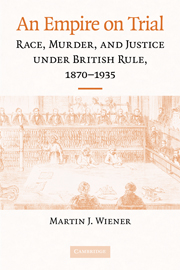Book contents
- Frontmatter
- Contents
- Preface
- Acknowledgments
- AN EMPIRE ON TRIAL
- Introduction
- 1 On the High Seas
- 2 Queensland, 1869–1889
- 3 Fiji, 1875–1885
- 4 Trinidad and the Bahamas, 1886–1897
- 5 India: The Setting
- 6 India: In the Legal Arena, 1889–1922
- 7 Kenya, 1905–1934
- 8 British Honduras, 1934
- Conclusion
- Bibliography
- Index
2 - Queensland, 1869–1889
Published online by Cambridge University Press: 05 June 2012
- Frontmatter
- Contents
- Preface
- Acknowledgments
- AN EMPIRE ON TRIAL
- Introduction
- 1 On the High Seas
- 2 Queensland, 1869–1889
- 3 Fiji, 1875–1885
- 4 Trinidad and the Bahamas, 1886–1897
- 5 India: The Setting
- 6 India: In the Legal Arena, 1889–1922
- 7 Kenya, 1905–1934
- 8 British Honduras, 1934
- Conclusion
- Bibliography
- Index
Summary
Great as the British race has been in the work of colonisation, it has not always been particularly happy in its treatment of inferior races.
Sydney Morning Herald, 11 July 1878I
In early 1884, the merchant ship the Hopeful was cruising off New Guinea, a land then outside the claims of any “civilized” state, seeking men to work the sugar plantations of the young and rapidly developing Australian colony of Queensland. At Moresby Island, impatient at the slow methods of negotiation, the second mate and recruiting agent, Neil McNeill, had the crew begin their operations by ramming native canoes that had come out to see what they wanted, and dragging their occupants aboard. They moved from island to island, repeating this brutally effective technique. When they met resistance, they shot the resisters; when two captives escaped one night, in the morning McNeill set fire to the village opposite where they were anchored, again shooting several natives who rushed out of the burning village. “Look here steward,” the shipmaster replied to a concerned seaman, “if you want to be in this trade you have got to be blind and see nothing.” On another day, several men escaped into the water, where McNeill and Barney Williams, the boatswain, shot them dead. It was for these last murders that they were to be tried in Brisbane, the capital of the colony, later that year, along with the master and the Government Agent, placed there by law to protect native recruits, but in fact, as he was later described, “a hopeless drunkard.
- Type
- Chapter
- Information
- An Empire on TrialRace, Murder, and Justice under British Rule, 1870–1935, pp. 39 - 70Publisher: Cambridge University PressPrint publication year: 2008

